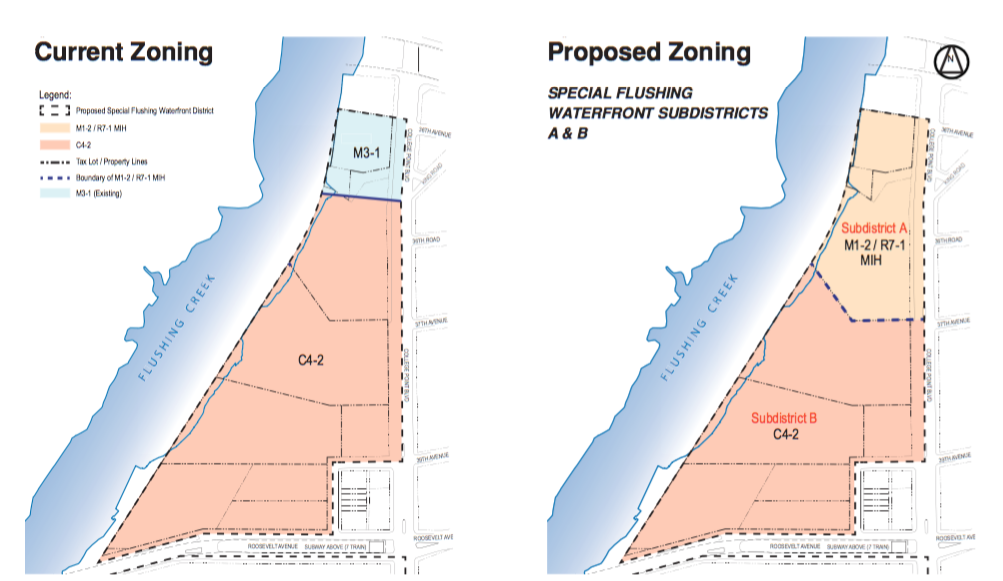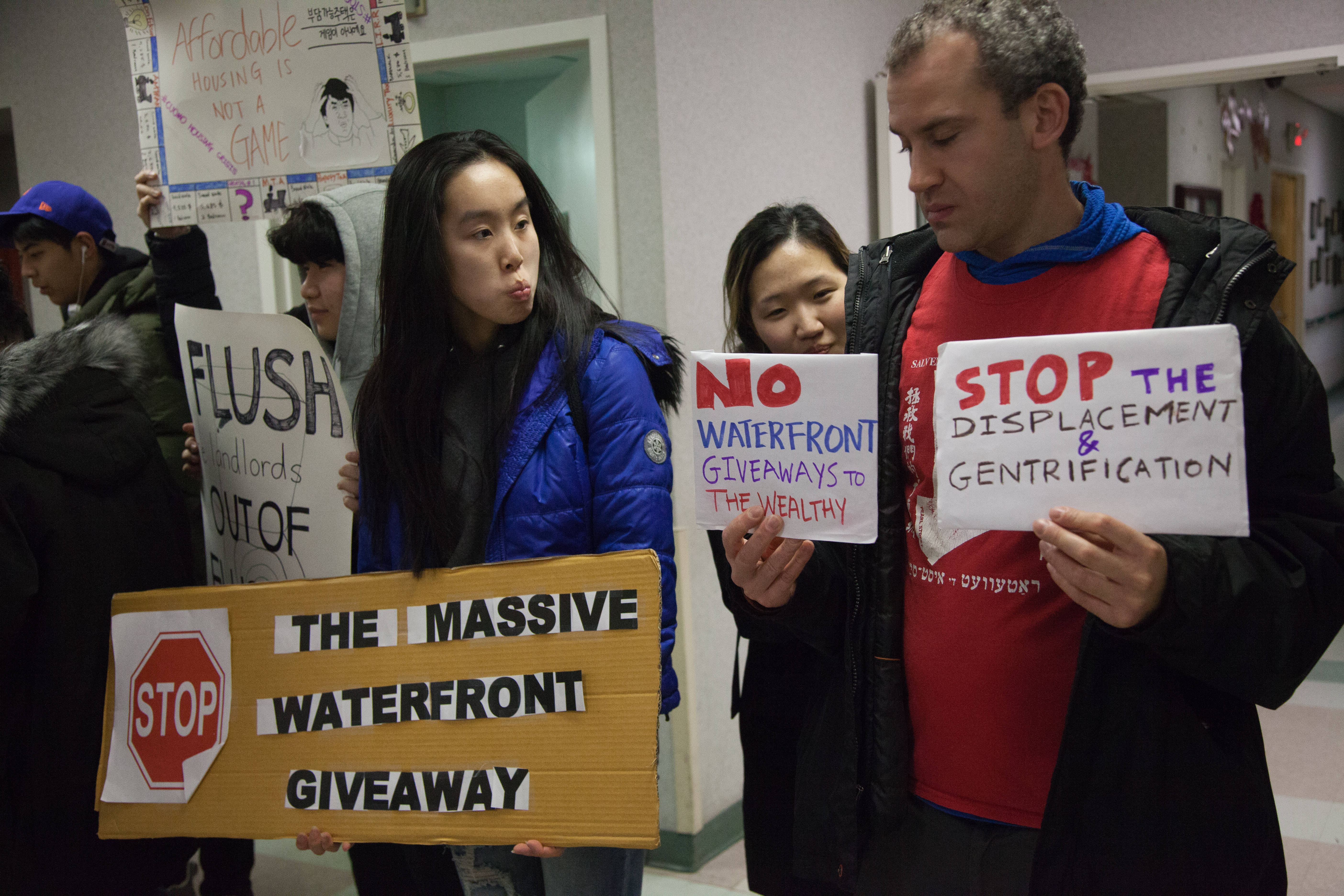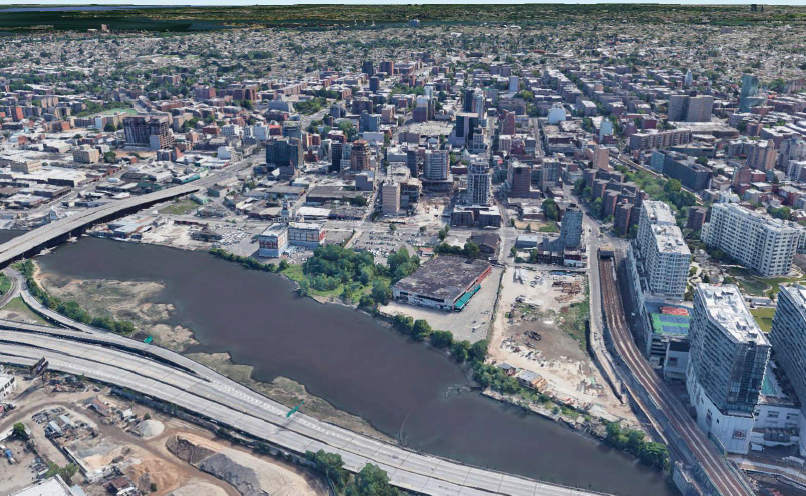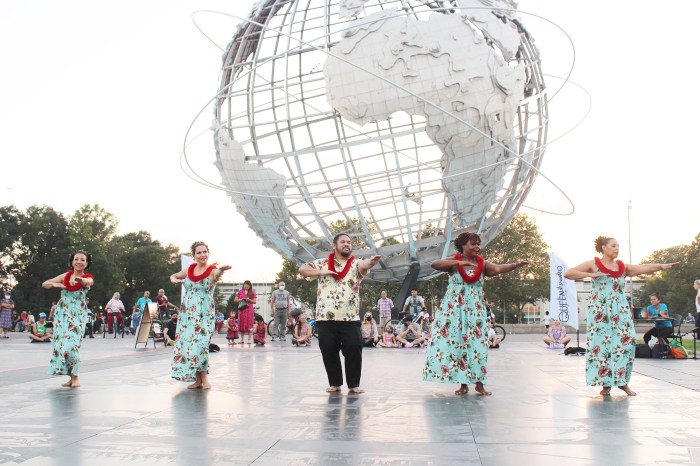As Community Board 7 gears up to vote on rezoning the Flushing waterfront next week, the public hearings over the project have made it increasingly clear that the community board’s concerns diverge from those of the activist-led resistance to the project.
The Community Board’s Land Use Committee met Wednesday, Jan. 29, and came up with 13 recommendations ranging from environmental to traffic calming measures for the proposed rezoning and large-scale development project. While the committee’s requests were numerous, they signaled conditional support of the zoning amendment.
On the other hand, the development’s opponents, led most prominently by a tenant group named the MinKwon Center, say that they are not inherently opposed to the redevelopment of the Flushing waterfront, but are particularly unsatisfied with its housing offerings, which include between 61 and 90 units of affordable housing out of the total 2,725 units. To them, the plan’s potential for displacement is a dealbreaker.
The developers, represented at recent public meetings by legal counsel Ross Moskowtiz, have pointed out that the zoning changes create no legal obligation to provide affordable housing in three of the four sites they are proposing.
At the public hearing on Jan. 21, Moskowitz framed the rezoning as a choice between two fixed options: take the community benefit of a new road system and an expanded public waterfront park or accept as-of-right development with no public benefits or affordable housing.
“I just want to make it perfectly clear to you. It’s going to be this type of development or it’s going to be an as-of-right development,” said Moskowitz.
A transformative proposal
The Special Flushing Waterfront District (SFWD) proposal would include nine buildings in the area enclosed by 36th Avenue to the north, College Point Boulevard to the east, Roosevelt Avenue to the south, and the Flushing Creek to the west.
The application was prepared by FWRA LLC, a joint partnership of the three major developers who own plots in the area. They claim that all-told the project would involve $1 billion of private investment, and would generate $28 million in annual revenue.
These towers would add 3.36 million square feet of development — the majority of which would be residential units or hotels. The 1,725 new apartments would take up 46 percent of the development, 879 new hotel units would take up the 20 percent and the remainder would go to office space, retail, community centers, parking and open waterfront space.
Though the plan covers a 29-acre swathe of land, the proposed rezoning is limited to a small patch that is currently zoned for manufacturing in the north end of the project. Because the developers are not attempting to change the zoning in three of the four proposed sites that are already zoned for a mix of commercial and residential, they have avoided requirements to build affordable housing in these areas.

Mandatory Inclusionary Housing laws only require them to add affordable housing in the one tower that is planned for the northern plot of land.
Aside from the affordable housing, the developers are offering infrastructural improvements that would not be part of as-of-right development. According to Moskowitz, the partnership between developers involved collaborating on elements of the plan like a continuous plans for roadways and waterfront park space.
In between the towers, the developers have proposed to build a new street system that would open the area up to pedestrian and vehicular traffic. Though the streets would be publicly accessible, the developers would maintain private ownership of the roads, which would be managed by a homeowners association.
The new district would contain a contiguous waterfront walkway that would be double the amount of open space of what would otherwise be required in an as-of-right plan.
“This is not a new project”
As Moskowtiz pointed out in his presentation to CB7, neither the plans for this project, nor the resulting fight over the future of downtown Flushing are new.
The push to develop rezone downtown Flushing and develop the waterfront property dates back to several planning and environmental impact studies that various city entities have conducted over the past 16 years.
The city created Downtown Flushing Development Framework in 2004 – a land use planning strategy for the area. In 2010, the Flushing Willets Point Corona Local Development Corporation (FWC LDC), helmed by former Queens Borough President Claire Shulman, secured a Brownfield Opportunity Area grant that studied how to redevelop the land and propose a rezoning.
These studies culminated in the Flushing West plan, a rezoning that spanned an 11-block area and proposed to build an estimated 3,316 new apartments. But because the Flushing West plan proposed a more expansive rezoning than the SFWD proposal, it meant that the MIH requirements for affordable housing were also significantly higher. It included about 515 to 619 affordable units, as opposed to the 61-91 in the SFWD plan.
Political pressure mounted against the 2016 plan–first from Senator Tony Avella and Assemblyman Ron Kim who cited transit congestion and environmental concerns, as well as the limits of MIH to provide deeply affordable units.
It was finally shelved by the Department of City Planning after Councilman Peter Koo came out staunchly against it in a letter he wrote to the city, citing similar concerns as Avella and Kim, in addition to noting that Flushing’s schools were already overcrowded.
Community board concerns
In its recommendations to the SFWD on Wednesday, the community board hit familiar concerns to the 2016 Flushing West plan. The biggest flashpoints for the Land Use Committee were the creation of a new school, traffic congestion and environmental impacts.
Of the 13 recommendations, three concern vehicular traffic, three concern environmental impacts and two concern education. Several of its most concrete and immediate recommendations involve asking several specific changes to the road system and asking for the expansion of the main street train station to Prince Street.
Of all the recommendations, however, only one concerns housing. The committee asked to ensure that community district residents are allotted 50 percent of the affordable units — a requirement that is already enforced by the city.
Land Use Committee Chair Joe Sweeney said that he was wary about losing the community benefits if the board does not come out in favor of the rezoning. He said that he was especially shocked to learn that the developers would not have to abide by the environmental recommendations of the 2014 Brownfield Study if the rezoning is struck down.
“People have to understand. There’s an as-of-right. If you object, do you want something that might have an effect on that river? If it’s turned down, fine. Live with what you’re going to get,” Sweeney said.
The recommendations would also require the developers to research and design a new school to accommodate children in downtown Flushing–a point that Moskowitz disputed at a recent public hearing on the rezoning.
“The analysis that we’ve done does not warrant the need of a new school,” said Moskowitz.
Councilman Koo was in attendance at the committee’s last meeting to listen to the discussion. He will have a 30-day period after the full community board votes on the plan, to reach a decision on whether to advance zoning in the ULURP process.

Tenant-led resistance
At the four meetings on the project over the past month, protesters with MinKwon Center and other local organizations have been a constant presence at the community board’s meetings.
A foundational issue for the protestors is that they feel like they had no voice in the planning process leading up to the current special district proposal. A statement that MinKwon releases asserts that the board began the ULURP process without prior community notice or feedback.
As urban studies professor Tarry Hum pointed out in the Gotham Gazette earlier this week, the community lost several pre-ULURP opportunities for public review and comment on a the special district proposal after the Department of City Planning found that the project would involve “no significant effect on the quality of the environment.”
“The massive rezoning of the Flushing waterfront will exponentially speed up the process of gentrification and displacement,” said MinKwon organizer Seonae Byeon.
Byeon also raised concerns that the developers have influenced the board by enlisting its Vice Chair Chuck Apelian as a consultant for the project. Though as a result of this work, Apelian has recused himself from voting on the project and declined to comment further.
The protesters have also found an ally in Assemblyman Kim, who has come out against the SFWD plan, in a move consistent with his opposition of the Flushing West rezoning. “Adding thousands of luxury condos is simply about extracting as much value and profits as possible out of our communities,” wrote Kim in a statement.

The Community Board will vote on the plan at an upcoming public hearing at 7 p.m. Feb. 10.
































